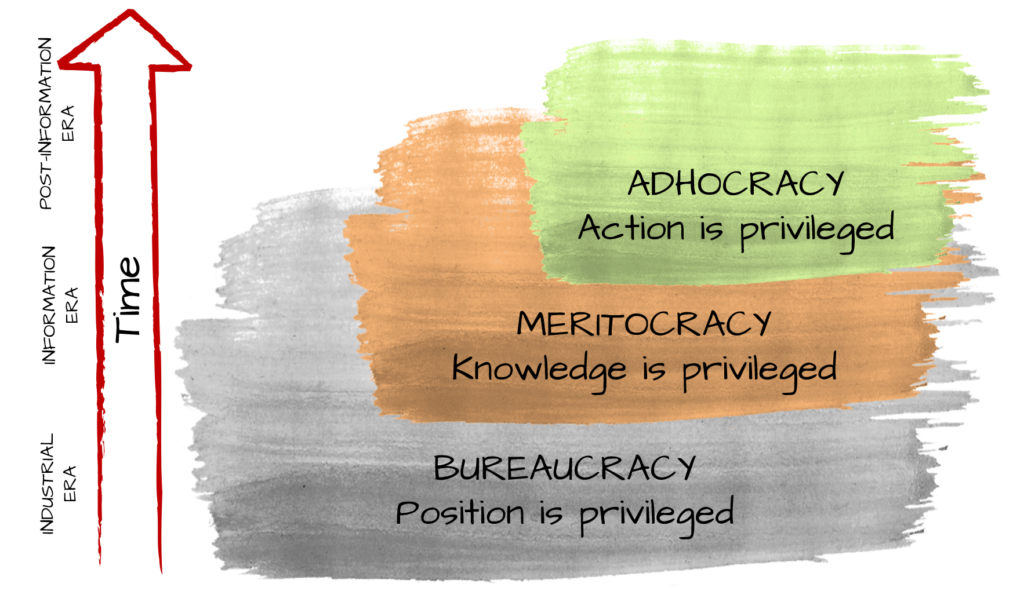I’m a massive fan of distributed autonomy. I believe that, in principle, giving people more autonomy at work is the largest organizational challenge the modern workplace faces.
Yes, the news of the day is either remote/hybrid work or the impact of AI on everyday jobs. Reinventing the organizational structures of a 21st-century corporation doesn’t belong to a broad discourse.
From both perspectives, however, distributed autonomy plays a pivotal role.
Autonomy in Remote Work
With remote work, the dependency is straightforward. Much of the work has moved from the office—where it could be physically supervised by a manager—to homes, where supervision is significantly limited.
The manager’s control is limited to the outcomes but not the actions that lead to them. For example, I can observe whether my engineers deliver features or add code to the codebase, but I don’t see when, how, and how much time they spend on activities that lead to “new features.”
Sure, some organizations would turn to digital tools to control employees’ activities. Guess what. It doesn’t work. Well, it does, but not the way they intend. Here’s what this kind of monitoring does to people:
- It reduces job satisfaction.
- It increases stress.
- It reduces productivity.
- It increases counterproductive work behaviors.
One hell of a slam dunk, really.
It’s not only the lack of control, though. It’s also the availability of help. For the vast majority of organizations, remote work creates additional communication barriers.
My leader no longer sits at the next desk. I can’t see whether it’s a good moment to interrupt them. Sure, I can drop them a DM on Slack, but they may not answer instantly. So, whenever I face one of those micro-decisions that I might have naturally delegated to my leader in the past, I may call a shot myself. It feels more convenient.
What has just happened here was me grabbing a little bit more authority. I might have had it all the time, but I didn’t use it because it was easier to ask the leader. Now, the path of least resistance is making decisions myself.
Multiply that by everyone in an organization, and suddenly, we have more distributed autonomy.
The choice is between embracing and strengthening the change or resisting it. In the latter case, well, we tax ourselves on every single front, from productivity to employees’ mental health. Not really a choice, is it?
Autonomy and AI
The emergence of AI creates another shift in the nature of work. We get a relatively powerful co-pilot that can help us with many tasks that would be difficult or arduous in the past.
Back then, we might have turned to the experts for help. Or drop the task altogether if it was non-essential.
The experts would give us a suggestion, and we’d accept it as the decision. If we abandoned the task, there would be no decision to make whatsoever.
But now, with our AI co-pilot, we have new capabilities at our fingertips. Yet it wouldn’t make any decision for us. Again, the path of least resistance is to grab some of that power, make a call, and move on.
As an example, it’s often a challenge to dig up a relevant source to link in my writing. I often remember a research paper or article covering a useful reference. But its topic or author’s name? Beats me.
Googling it was always a struggle, so I either turned to a human expert friend or gave up.
But now? LLMs are pretty decent in digging up relevant options. Still, the work of reviewing suggested sources and choosing a valuable one is on me. I now face a decision that I earlier deferred to an expert or dodged entirely.
More autonomy again.
Adhocracy
The changes coming from different directions align with a broader evolution of the nature of work. Julian Birkinshaw, in his book Fast/Forward, provides a neat big picture.
Over the past century or so, the world has evolved from the industrial, through the information, to the post-information era. Each step changes the rules of the game.
A hundred years ago, scaling was the biggest challenge, and the effective use of resources was advantageous. Thus, bureaucracy was a winning strategy.
In the second half of the 20th century, we saw the increasing value of information, and its accessibility and effective use gave us an edge. Thus, meritocracy was gaining ground.
Now, information is ubiquitous. In fact, with the help of LLMs, we can easily generate as much of it as we want. The world becomes less about who knows what. It’s about who can act upon (incomplete) data in a fast and effective manner. Thus, ad-hoc action gives an advantage.

Birkinshaw coins the term adhocracy to describe this new mode of operation.
A side note: one important part of the model is that all three modes of operation coexist. However, an organization will defer to the default mode whenever it faces uncertainty. We can’t expect a bureaucratic, hierarchical behemoth to act in an adhocratic way routinely.
The coexistence of all modes will naturally create tension. The decision can’t be made at the same time made by:
- a manager with the most positional power
- an expert with the best data and most expertise
- a line professional involved in the task hands-on
If we want to embrace adhocracy, which Birkinshaw argues is a prerequisite for organizational survival, we necessarily must move authority down the hierarchy.
We need to distribute more autonomy. Again.
Common Part
It’s not a surprise. When you go through the stories of companies successfully embracing non-orthodox management models, autonomy would be one shared part of all.
Be it a turnaround story in David Marquet’s, unsurprisingly titled, Turn the Ship Around, or Michael Abrashoff’s It’s Your Ship, pushing autonomy down the hierarchy was crucial.
And the fact that the military context would pop up so frequently in this discussion shouldn’t be a surprise. Decentralizing control was a pivotal part of the revolution of the 19th-century Prussian army. Its victory streak forced other armies to follow suit.
Yes, the corporate world, despite all its inspirations from the military lingo, takes its sweet time to adopt the truly important inventions. And yes, our views of the military tend to be rooted more in Hollywood movies than in the actual realities of these gargantuan organizations.
I often mention that we’d see more distributed autonomy in late 19th-century armies of the West than in many 21st-century corporations.
We’ll arrive at the same conclusion if we stick to management theory. Take Holacracy, Sociocracy, Teal, or whatever generates the most buzz these days. The cornerstone of each of those will be autonomy. It may go into how we design roles (Holacracy), get to the principle list (self-government in Teal), or define the decision-making process (consent in Sociocracy). But it’s always there.
When you think of it, it’s only natural. For hundreds of thousands of years, homo sapiens lived in small tribes of hunter-gatherers that were egalitarian and had very little to no hierarchy.
Even when our species started evolving into bigger societies, adopting a strong hierarchy wasn’t given and was only one of the possible ways of coordination.
I’d speculate that we are genetically predisposed to autonomy.
Reinventing Autonomy
Wherever we look, we seem to be reinventing the role of distributed autonomy. It’s critical to succeed on a battlefield. Staying relevant in business increasingly requires its presence. It sneaks along with the changes in the nature of work. We know it’s a prerequisite for engagement and motivation.
Nothing should be easier than embracing the change and giving people more power.
Sadly, it’s not the case. Power is a privilege. And as with every privilege, those in power will not give up easily. The good old bureaucracy will fight back.
More importantly still, even if we have the means to overcome the resistance, the challenge is not as easy as “Let’s just give people more autonomy.”
We need to take care of other things before we embark on this journey. But that’s the topic for another post.
This is the first part of the short series of essays on autonomy and alignment. The following part(s) will be published on the blog and linked here during the next weeks.
Feel free to subscribe/follow here, on Bluesky, or LinkedIn for updates.
I also run the Pre-Pre-Seed Substack, which is dedicated to discussing early-stage products.


Leave a Reply